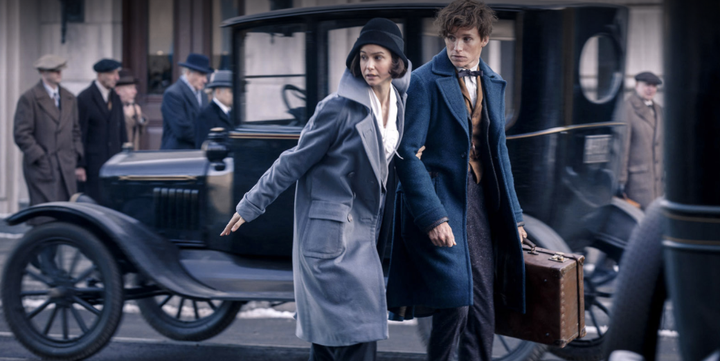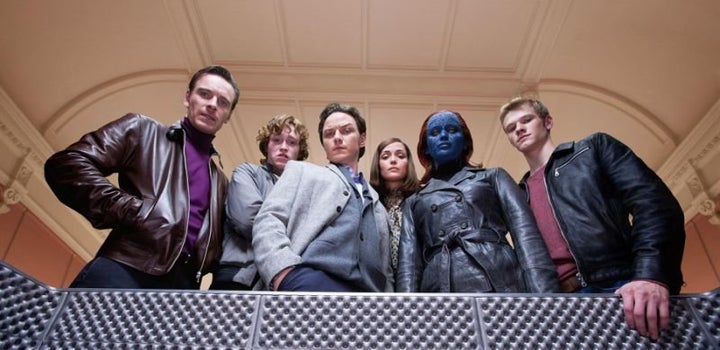
The charm and wonder of “Fantastic Beasts and Where to Find Them” begins to crumble when you consider the fact that it’s set in New York City in 1926.
It takes place during the height of the Jazz age and the Harlem Renaissance. And yet its cast, led by Eddie Redmayne and Katherine Waterson, is abundantly, blindingly white.
Hollywood’s so-called “diversity” issue has been a trendy, hot-button topic for some time, but the whiteness of “Fantastic Beasts” is indicative a problem specific to fantasy and science fiction film: they’re metaphors for real-life racism and oppression that erase non-white people.
Written by JK Rowling and set in the “Harry Potter” universe, “Fantastic Beasts” follows British wizard Newt Scamander as he navigates the American wizarding world for the first time, attempting to collect a bevy of magical beasts that have escaped from his enchanted briefcase. He does all this, for the most part, in a New York City that is eerily whitewashed ― even in a scene where he visits a Harlem speakeasy.
Last year, when fans on social media voiced concern about an all-white cast, JK Rowling assured them via Twitter:
She’s right. There are a smattering of non-white characters throughout the film, though few have speaking roles and only one, Carmen Ejogo as MACUSA president Madame Picquery, has a major speaking role. In one scene, a black female house elf sings a jazz song at a magical speakeasy. A house elf.
Genre films are all about shifting perspective and pushing the limits of our imagination. They’re all about suspension of disbelief. So, why is it so hard to believe in a future or a magical past that includes people of color?
So often these films create very little room for the presence of black people and other people of color. The irony of this (and what makes it so incredibly frustrating) is that these narratives mirror the real-life oppression of marginalized groups.
It can be argued that, at its core, “Harry Potter” is a story about fighting against oppression and fascist rule. Throughout the “Harry Potter” series, we see the discrimination of wizards with non-magical ancestry, derogatorily referred to as “mudbloods.”
Just as Voldermort looms over the entire “Harry Potter” series as a kind of Hitler-esque figure, so too does the character Grindelwald in “Fantastic Beasts,” a dark wizard who believes in the supremacy of magical folks over Muggles, who wants to spark an ostensible race war between wizards and Muggles “for the greater good.” The parallels to white supremacy are obvious.
And yet, all the major players in the film are white.

This is a common practice. In genre movies like “Star Wars,” “Lord of the Rings,” “X-Men,” “Divergent,” and the upcoming “Ghost in the Shell,” real-life oppression is met-aphorized in stories of dystopian worlds, but race almost never comes into the equation.
The “X-Men” franchise, for instance, attempts to expose the ills of racism by borrowing the social and political discrimination of people of color as fodder for its mostly white mutants, who are hunted down and exterminated for their superhuman abilities. Professor X and Magneto have often been seen as stand-ins for Martin Luther King and Malcolm X. This is oversimplified erasure.
There’s a kind of danger in using racial oppression as a model, because it is, by its very nature, not universal.
This is not a question of calling for “diversity” for diversity’s sake. This is about missed opportunities. Because even genre films that do feature black characters tend to gloss over the race of these characters, taking a color-blind approach that merely amounts to tokenism. How much richer would it be to acknowledge and explore, for instance, a black women who is powerful in the Wizarding world but experiences micro-aggressions and oppression in the Muggle world? How much more nuance could that afford? If there were ever a way to expand, to pull apart and pull open that world ― how much more could we learn?
There are sci-fi and fantasy films that have approached race in a more interesting, nuanced way. The brilliant 1984 film “Brother From Another Planet” engages gamely with race, starring Joe Morton a black alien slave who flees from the white slave masters of his home planet. More recently, “The Hunger Games” series acknowledged the racial and socio-economic divide between the mostly-black District 11 and the rich, mostly-white metropolis known as The Capitol. (The film was, however, accused of whitewashing heroine Katniss Everdeen by casting Jennifer Lawrence).
Genre cinema is about escape, so some might argue that acknowledging and exploring race in less oblique, metaphorical ways isn’t necessary. But genre cinema is also about imagining new worlds in order to make sense of our real world. If we can imagine lightning speed space-travel and monstrous dragons, why can’t we imagine scenarios that don’t erase or decontextualize race in hypothetical futures and make-believe pasts?
Fantasy and sci-fi films that exclude or glaze over race even as they tell stories of fighting against oppression do an extreme disservice to the people of color who are just as eager for the latest blockbuster as anybody else. There is no point, no value in asking us to empathize with hypothetically oppressed people if people who are actually oppressed in real life are excluded from the narrative.

